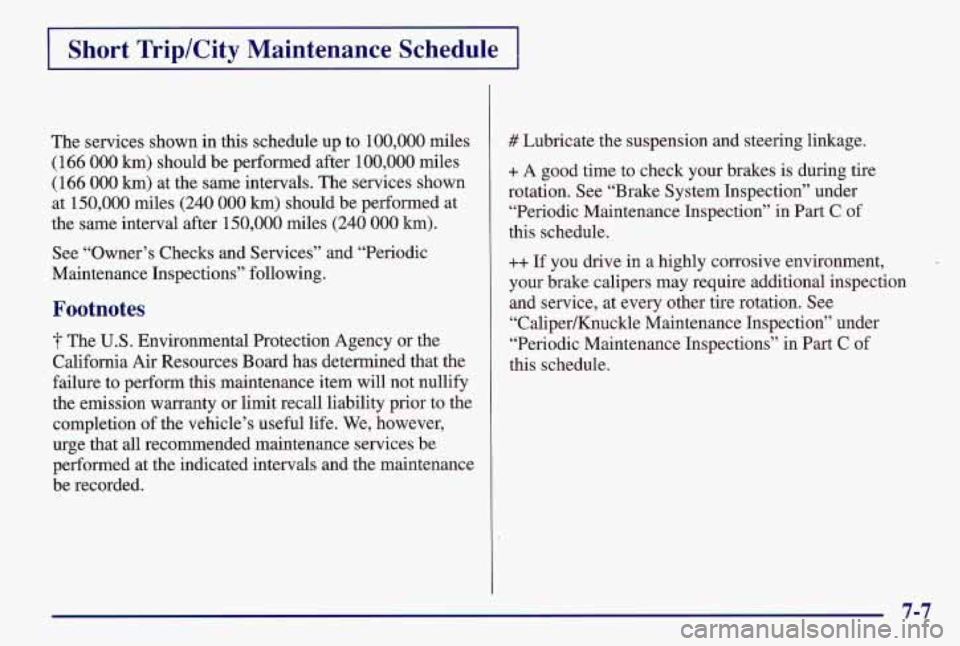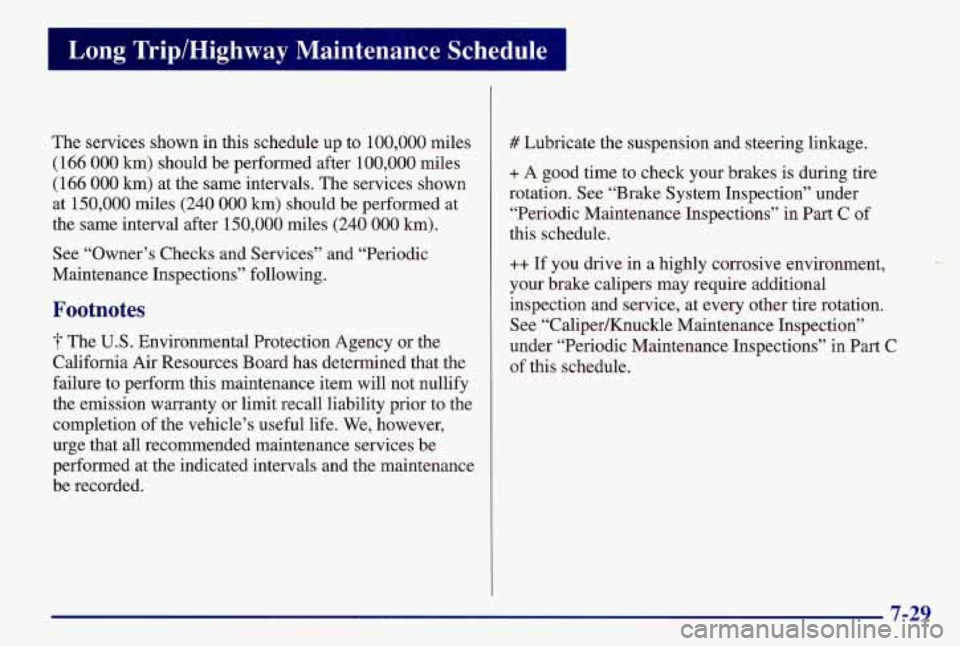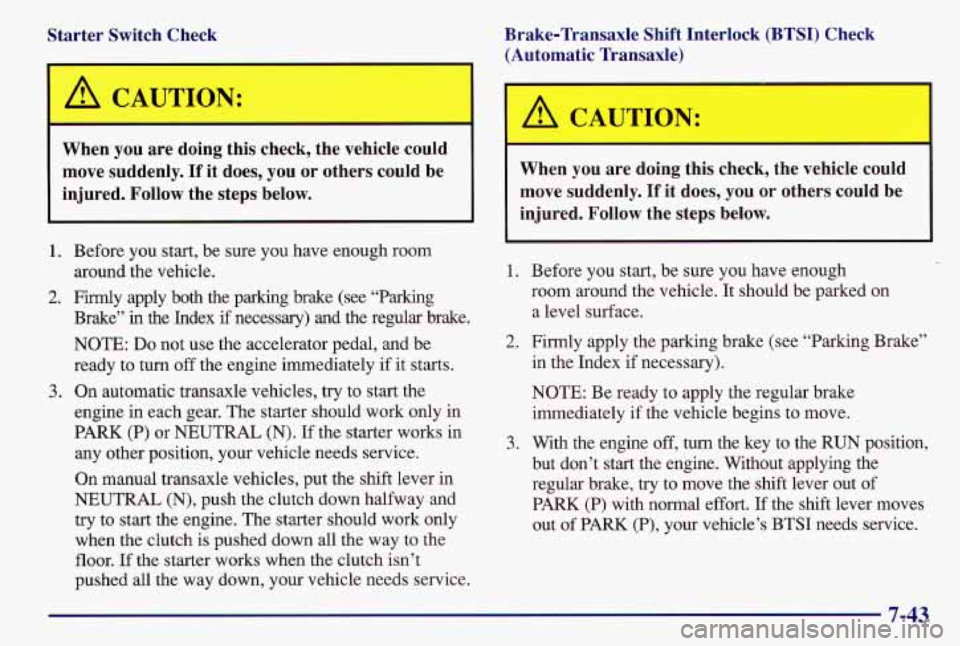Page 275 of 371
A CAUTION: I
Using the wrong replacement wheels, wheel bolts
or wheel nuts on your vehicle can be dangerous.
It could affect the braking and handling
of your
vehicle, make your tires lose air and make you
lose control. You could have
a collision in which
you or others could be injured. Always use the
correct wheel, wheel bolts and wheel nuts
for replacement.
NOTICE:
The wrong wheel can also cause problems with
bearing life, brake cooling, speedometer or
odometer calibration, headlamp aim, bumper
height, vehicle ground clearance and tire or tire
chain clearance to the body and chassis.
See
“Changing a Flat Tire” in the Index for
more information.
Used Replacement Wheels
I A CAUTION:
Putting a used wheel on your vehicle is
dangerous. You can’t know how it’s been used or
how
far it’s been driven. It could fail suddenly
and cause an accident.
If you have to replace a
wheel, use a new GM original equipment wheel.
I
6-48
Page 288 of 371

Fuse
INT LPS
PWR ST
RDO IGN HTR-A/C
CRUISE
TAIL LPS
LTR WIPER
02
DR UNLK
Usage
Alarm Module (Illuminated Entry,
Warning Chimes, Overhead
Lamps, Map/Reading Lamps,
Glove Box Lamp, Trunk Lamp,
Radio, Power Mirrors), Anti-Lock
Brakes, Variable Effort Steering
Power Seat
Radio Heater/Air Conditioning Blower.
Daytime Running Lamps,
Automatic Light Control
Cruise Control
Parking Lamps, Taillamps
,
Sidemarker Lamps, License
Lamps, Instrument Panel Lights,
Headlamp Warning Alarm
Cigarette Lighter
Windshield Wipers/Washers Heated Oxygen Sensors
Automatic Door Unlock
Fuse
ALARM
FOG/FTP
PRNDL
DR LK
2
AIR BAG
HORN
INST STOP HAZ
PCM
DR LK
1
INST LPS
RR DEF HDLP
Usage
Automatic Transaxle, Automatic
Door Unlock, Alann Module
(Illuminated Entry, Warning
Chimes), Traction Telltale, Rear
Window Defogger, Remote
Keyless Entry
Fog Lamps
Instrument Cluster, Powertrain
Computer, Park-Lock Solenoid.
Electronic PRNDL
Door Locks
Air Bag-Power
Horn, Service Tool Power
Instrument Cluster Stoplamps, Hazard Lamps,
Anti-Lock Brakes
Powertrain Control Module
Door Locks, Remote Keyless Entry
Instrument Panel Lights,
Fog Lamps
Rear Window Defogger
Headlamps, Daytime Running
Lamps (Circuit Breaker)
6-61
Page 289 of 371
Engine Compartment Fuse Block
F/P,INJR I IGN MOD 1 L b1
ABSiEVO PCM BATT I
Fuse
F/P INJ
ERLS
The engine compartment fuse block
is located on the
driver’s side
of the engine compartment, near the battery.
ABSEVO
Usage
Fuel Pump, Fuel Injectors Back-up Lamps, Canister
Purge Valve, EGR, Automatic
Transmission, Brake
Transmission Shift Interlock,
Anti-Lock Brakes, Variable
Effort Steering, Air Conditioning Compressor, Park
Lock Solenoid
Anti-lock Brake Solenoids,
Variable Effort Steering
6-62
Page 290 of 371
Fuse
IGN MOD
HVAC BLO
MOT
PCM BATT
CLG FAN
HDLP
STOP LPS PWR
ACC
RR DEFG
ABS
IGN
SW
Usage
Ignition System
Heater/Air Conditioner-High
Blower, Generator-Voltage Sense
Powertrain Computer
Engine Cooling Fan
Lighting Circuits
Power Accessories, Stop Lamp Circuits,
Rear Window Defogger
Anti-Lock Brakes, Variable
Effort Steering
Ignition Switch Circuits53
Steering Wheel Controls (If Equipped) Fuse Panel
Your steering wheel radio controls are protected by
fuses.
For service, contact your Pontiac
service department.
Replacement Bulbs
OUTSIDE LAMPS BULB
Back-up Lamps ......................... 2057
Front Parkingnurn Signal Lamps
........ 2057 NA
Center High-Mounted Stoplamp
... ... 912
Halogen Headlamps
Low-Beam
....... ,.. ........... 9006
High-Beam
........................... 9005
Stop/Tail/Turn Signal Lamps
............. 2057
INSIDE LAMPS
Dome Lamp .... .........
BULB
. 161
6-63
Page 294 of 371
7 Section 7 Maintenance Schedule
This section covers the maintenance required for your Pontiac. Your vehicle needs these services to retain its safety,
dependability and emission control performance.
7-2
7-2
7-3
7-4 7-4
7-4
7-7
7-29
7-4
1
7-41 7-41
7-42 Introduction
Your Vehicle and
the Environment
How This Section is Organized
Part A: Scheduled Maintenance Services
Using Your Maintenance Schedule
Selecting the Right Schedule
Footnotes Footnotes
Part
B: Owner Checks and Services
At Each Fuel Fill
At Least Once a Month
At Least Twice a Year 7-42
7-45
7-45
7-45
7-45
7-45
7-46
7-46
7-47 7-49 At
Least Once a Year
Part
C: Periodic Maintenance Inspections
Steering, Suspension and Front Drive
Axle Boot and Seal Inspection
Exhaust System Inspection Radiator and Heater Hose Inspection
Throttle Linkage Inspection
Brake System Inspection Caliper/Knuckle Maintenance Inspection
Part
D: Recommended Fluids and Lubricants
Part
E: Maintenance Record
Page 300 of 371

Short TriplCity Maintenance Schedule
The services shown in this schedule up to 100,000 miles
(166 000 km) should be performed after 100,000 miles
(166 000 km) at the same intervals. The services shown
at
150,000 miles (240 000 krn) should be performed at
the same interval after
150,000 miles (240 000 km).
See “Owner’s Checks and Services” and “Periodic
Maintenance Inspections’’ following.
Footnotes
The U.S. Environmental Protection Agency or the
California
Air Resources Board has determined that the
failure to perform this maintenance item will not nullify
the emission warranty or limit recall liability prior to the
completion of the vehicle’s useful life. We, however,
urge that all recommended maintenance services be
performed at the indicated intervals and the maintenance
be recorded.
# Lubricate the suspension and steering linkage.
+ A good time to check your brakes is during tire
rotation. See “Brake System Inspection” under “Periodic Maintenance Inspection’’ in Part
C of
this schedule.
++ If you drive in a highly corrosive environment,
your brake calipers may require additional inspection
and service, at every other tire rotation. See
“Caliper/Knuckle Maintenance Inspection” under
“Periodic Maintenance Inspections” in
Part C of
this schedule.
7-7
Page 322 of 371

The services shown in this schedule up to 100,000 miles
(166
000 km) should be performed after 100,000 miles
(166
000 km) at the same intervals. The services shown
at 150,000 miles
(240 000 km) should be performed at
the same interval after
150,000 miles (240 000 km).
See “Owner’s Checks and Services” and “Periodic
Maintenance Inspections” following.
Footnotes
The U.S. Environmental Protection Agency or the
California Air Resources Board has determined that the
failure to perform this maintenance item will not nullify
the emission warranty or limit recall liability prior to the
completion of the vehicle’s useful life. We, however,
urge that all recommended maintenance services be
performed at the indicated intervals and the maintenance
be recorded.
# Lubricate the suspension and steering linkage.
+ A good time to check your brakes is during tire
rotation. See “Brake System Inspection” under “Periodic Maintenance Inspections” in
Part C of
this schedule.
++ If you drive in a highly corrosive environment,
your brake calipers may require additional
inspection and service, at every other tire rotation.
See “Caliper/Knuckle Maintenance Inspection”
under “Periodic Maintenance Inspections” in Part C
of this schedule.
7-29
Page 336 of 371

Starter Switch Check
A CAUTION: ,
I
When you are doing this check, the vehicle could
move suddenly.
If it does, you or others could be
injured. Follow the steps below.
1.
2.
3.
Before you start, be sure you have enough room
around the vehicle.
Firmly apply both the parking brake (see “Parking Brake”
in the Index if necessary) and the regular brake.
NOTE:
Do not use the accelerator pedal, and be
ready to turn off the engine immediately if
it starts.
On automatic transaxle vehicles, try
to start the
engine in each gear. The starter should work only in
PARK
(P) or NEUTRAL (N). If the starter works in
any other position, your vehicle needs service.
On manual transaxle vehicles, put the shift lever in
NEUTRAL
(N), push the clutch down halfway and
try to start the engine. The starter should work only
when the clutch is pushed down all the way to the
floor.
If the starter works when the clutch isn’t
pushed all the way down, your vehicle needs service.
Brake-Transaxle Shift Interlock (BTSI) Check
(Automatic Transaxle)
A CAUTION:
When you are doing this check, the vehicle could
move suddenly. If
it does, you or others could be
injured. Follow the steps below.
1. Before you start, be sure you have enough
room around the vehicle.
It should be parked on
a level surface.
2. Firmly apply the parking brake (see “Parking Brake”
in the Index if necessary).
NOTE: Be ready to apply the regular brake
immediately if the vehicle begins to move.
3. With the engine off, turn the key to the RUN position,
but don’t start the engine. Without applying the
regular brake, try to move the shift lever out
of
PARK (P) with normal effort. If the shift lever moves
out of PARK (P), your vehicle’s BTSI needs service.
7-43